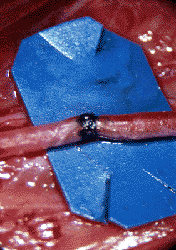Laser welding is the technique of which uses laser energy to achieve the bonding of two tissues pieces. There are two types of laser welding under development:
- Photothermal welding
Laser energy is converted into heat which causes thermal denaturation of proteins that create a thin layer of "glue" to hold the two tissue surfaces together. The role of protein "entanglement" and of thermally induced "crosslinkages" are still being investigated but are a possibility. A common strategy is to used an albumin paste stained with an absorbing chromophore such as indocyanine green which selectively absorbs the laser energy. Hence, only the paste becomes hot which bonds the two tissue surfaces while the collateral thermal injury to surrounding tissues is minimized.
- Photochemical welding
Photoactivated crosslinking reagents can join two tissues. The reagent is placed between the two surfaces to be joined. Light activates the reagent causing crosslinked bridges between the two surfaces. Hence, tissues are bonded without any heat. Mel Judy and colleagues at the Baylor Research Institute, Dallas, TX, have developed a 1,8-napthalimide crosslinking agent for laser welding of tissues link to abstracts.
 A cut vein is rejoined using laser welding. Medical Photonics Laboratory, Health Care Technologies Program, Lawrence Livermore National Lab. link | Laser welding.Such "sutureless surgery" can achieve rapid sealing of lacerated tubular structures. |
NewsEtc. Index
OMLC home page